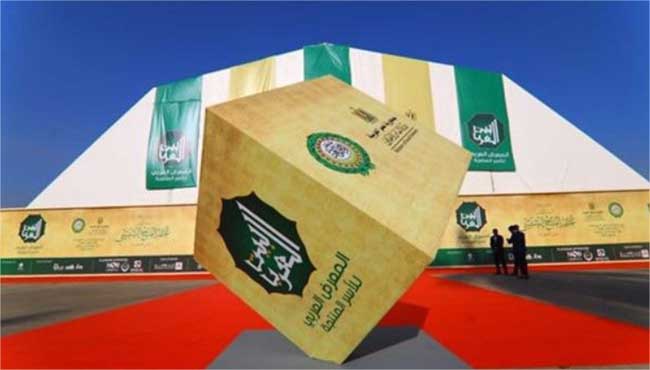With a big smile and amused eyes, Deema Al-Shaiya, a Saudi woman in her late 20s, made an understanding nod to curious questions over the perfectly crafted hand-made dolls that were put on display in the Saudi pavilion of Beit Al-Aarab (House of Arabs), an exhibition for traditional crafts from all across the Arab countries that are being hosted in Cairo 5-11 January.
“I know it comes as a surprise to many that we have dolls on display in our pavilion because of the assumption that in the collective Saudi culture, it is prohibited to have dolls, but this is not entirely true,” she said.
The traditional wisdom around Saudi culture is that dolls, statues or drawings of humans, birds or animals are incompatible with Islam. This is generally believed to be a cultural heritage from early Islam over 15 centuries ago, which replaced beliefs in the land now known as Saudi Arabia that included statue worship.
Not anymore, according to Al-Shayaa.
The crocheted and stuffed dolls on display, priced at nearly EGP 1,500, were made by Saudi girls and women trained in programmes sponsored by the Saudi Social Development Bank to foster financial independence for women through home-work opportunities.
“Things are changing in Saudi Arabia and what we have on display here in Beit Al-Aarab reflects the evolution of a vibrant and young society moving forward,” she said.
Al-Shaya herself, as chair of communications of the initiatives of the Saudi Social Development Bank, is emblematic of the changes that Saudi society is going through.
Fashionably veiled, Al-Shayaa has studied business in the UK and fashion design in Saudi Arabia. “I know it often comes as a surprise to many people when I say it, but in fact, we do not just have fashion schools in Saudi Arabia today, but we actually have a fashion commission [set out in 2020] that is there to enable the thriving fashion industry in the Saudi Arabia of today,” she said.

This said, Al-Shaya argued that “the evolution that the society is going through is not coming at the expense of a dedicated commitment to heritage conservation. Sitting next to Al-Shaya is Khala Badriya (Aunt Badriya) in the traditional Bedouin Saudi outfit that only reveals her firmly kohl-defined black eyes working on an old weaving instrument to make Al-Sadoue, a traditional small carpet that is hung on walls for decoration in some houses.
“We are sticking to the old, and we are bringing in the new; we are also giving a touch of modernity to some old crafts. This what we are here for; we want to show our diverse and evolving culture,” she said.
Diverse and evolving culture seemed to be the dominating theme of the most participant in this first-ever all-encompassing Arab crafts exhibition that is co-organised by the Ministry of Social Solidarity in Egypt and the League of Arab States and hosted at Al-Kouba Palace in the east of Cairo.
In the exhibition’s largest pavilion, dedicated to Egyptian participants, Hagar Adam and Mahmoud Boughdadi showed their skill in giving a new lease of life to the saaidi deka (a traditional wooden bench that is often put at the entrance of houses in Upper Egypt). What was formerly a less-than-fashionable piece of furniture was turned into a modern and colourful piece of furniture that could serve as a coffee corner in any modern house.
“This sounds like a cliché but what we have learned through experience is that accommodating modernity is the only way to give a new lease on life to many things that could just get outdated,” Adam said.
Also on display in the Egyptian pavilion are items showing the evolution of hand-crafted textiles from Akhmim and Nagada, in Upper Egypt, into fashionable outfits or decorative items for the home. Participating artisans said they were getting a lot of attention from visitors for their crafts that have been worked in different colours, sizes and designs, showing the flexibility of these traditional crafts and the ability of these artisans to match the modern taste.

In the Sudanese pavilion, Rim Abdel-Fattah is showing her ability to play around with the traditional intense Sudanese scents and henna (mehandi) drawings to give them a modern imprint that interests non-Sudanese women.
“I got a lot of attention for my products from visitors to this pavilion, and I think I had a chance to show something new about our Sudanese culture, but I also had a chance to network in pursuit of some new markets for our products,” Abdel-Fattah said.
Networking and marketing were named by many participants in Beit Al-Aarab as two definite advantages of the gathering.
Participants also spoke of the exhibition as an opportunity to be introduced to the shared elements of culture.
Heba Zourikat, who displayed table coasters, bookmarks and make-up bags knitted in the traditional Jordanian colourful petit points stitches, said she was impressed by the similarities this traditional Jordanian and Palestinian needlework has with the almost identical crafts on display in the exhibition from Sinai.
“So it is about networking, but it is also about finding grounds for possible shared opportunities,” Zurikat said.
Of the 22 member states of the Arab League, 12 are present in the exhibition. In her remarks at the event's opening, Minister of Social Solidarity Nevine El-Qabbaj said the exhibition offered an opportunity for sharing experiences among participants who are key contributors to the preservation of Arab cultural heritage.
Short link: